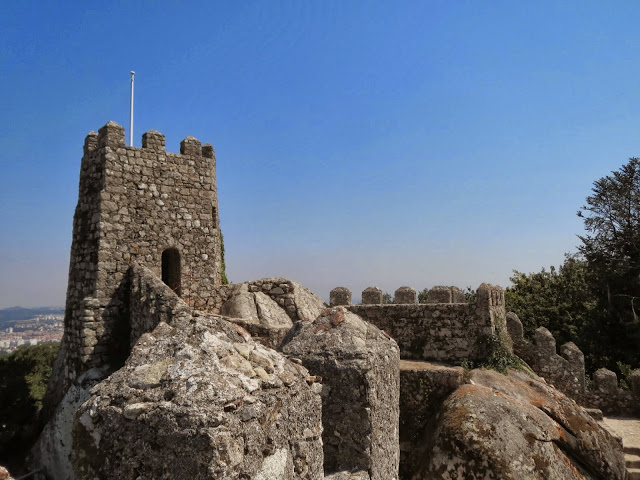First, this is the only picture I got of my three travel companions. And there are no pictures of the four of us together. Too funny! (but note the empty large beers)
A view of the city from the main park, Parque Eduardo VII. Our apartment in Chiado is on the hill to the right.
Portugal's national drink (after Port) is Ginjinha, a sour cherry liquor. There were several of these shops all around the city, where you could buy a shot to drink at the counter, or a bottle to go (we did both!)
There were lots of beautiful & old churches to explore. This 1st one, Ingreja de São Domingos, is considered a national monument. The church managed to survive the 1755 earthquake & a fire in 1959.
A few other church photographs - all were located on our apartment street, Rua Garrett
In addition to touring around Lisbon, we also spent some time outside of the city. In Sintra & Fatima. Both were day trips, one by train (Sintra) and one by car (Fatima).
By the way, I love train travel in Europe. And metros, and walking. When I eventually move back to the US, I'm going to dread having to get into a car to go EVERYWHERE, and that most places are in a shopping center or the 'burbs.
Sintra and it's surrounding hills are classified as a UNESCO world heritage site. There is a Royal Palace which was used by Portuguese royalty until the 1910 revolution. There is also the remains of a Moorish castle and the Pena Palace, both located within the surrounding hills
Our 1st visit was to the Royal Palace.
It was inhabited by royalty from the early 15th to late 19th centuries.

Definitely a mixture of Arab, Moorish and Renaissance art & architectural styles
A walk around the town of Sintra revealed some interesting homes, churches, and a clock tower.
From the town, you could see the remains of the Moorish Castle on top of one of the hills. We took a bus to the top to look at it closer.
The castle was built during the 8th and 9th centuries, during the Arab occupation of the Iberian Peninsula. After the 1197 conquest of Lisbon, the castle was turned over to the Christians. The 1755 earthquake caused considerable damage to the castle, and it wasn't until 1838 that any restorations were started
In the 20th century, there were several projects to restore and repair sections of the castle, allowing it to be visited by travelers. They were currently doing some excavation work as well.
My Dad started a "conversation" with this guy. And even though the man only spoke Portuguese, Dad learned that he couldn't walk hills due to heart surgery.
me
Pat
Pat was FAR AWAY, on top of the castle walls.
A view of the city of Sintra from above
This is the Pena Palace. It's also a UNESCO World Heritage site.
It started as a small chapel in the Middle Ages, and then a monastery was built on the site in the 15th Century. Unfortunately, the monastery was destroyed during the 1755 earthquake. But the chapel somehow survived.
In the mid 1800's, King Ferdinand I had it rebuilt into a palace that was used by the royal families as their summer residence.
It's a mix of different architectural styles - Gothic, Islamic, Renaissance
There were lots of interesting tiles
What a face! I discovered that he's a newt, symbolizing the creation of the world
These are the stained glass windows in the original chapel (although I'm sure the windows themselves are not originals!)
The Cloister
Sweet gargoyle :)
Scary gargoyle!
I loved the kitchen. I have copper pot envy & need a few of those wine vessels for personal use
King Ferdinand II.
Finally, we visited Fatima.
If you don't know the significance of Fatima, it is known as being the location where in 1917, three children saw an apparition (referred to as The Lady of Our Rosary). The Lady told the children she was sent by God to give a message prayer, repentance and consecrations. She visited the children each month on the 13th day from May 13 - October 13. The last apparition occurred on October 13, and was witnessed by 70,000 pilgrims. On this day, she sent a message that consisted of three secrets:
1.) The first secret was a vision of Hell "where the souls of the sinful would travel without prayer";
2.) The second secret was a statement that World War I would end and a prediction of another war, World War II during the reign of Pope Pius II, should men continue offending God and should Russia not convert
3.) The third secret was written down by one of the children in 1944, and held by the Vatican until 2000. There is much controversy about what the secret actually states. One version is that referenced the persecution of Christians in the 20th Century. But other believe that the actual secret has never been revealed.
Two of the children died at an early age and were beatified in 2000 by Pope John Paul II. The third child lived until 2005.
Unfortunately, we were a little disappointed in this visit. Maybe we didn't expect it to be so modern? Maybe we expected something different from a place which is visited by 4 million people each year? But we're still glad we saw it

















































































